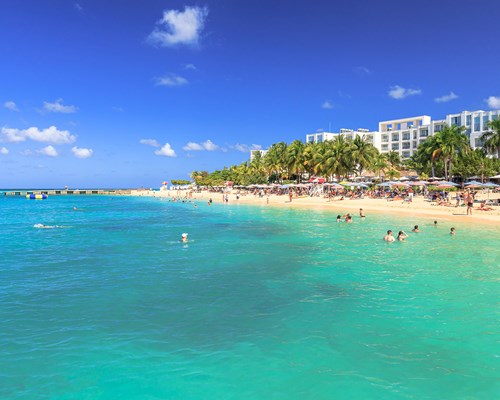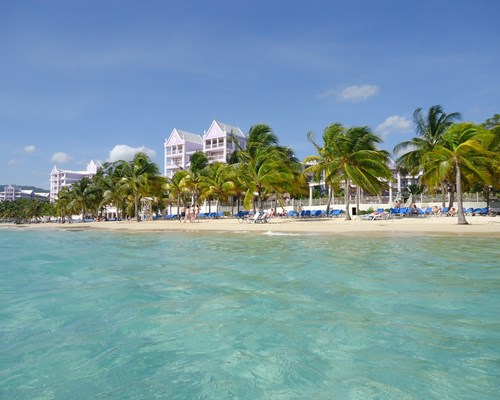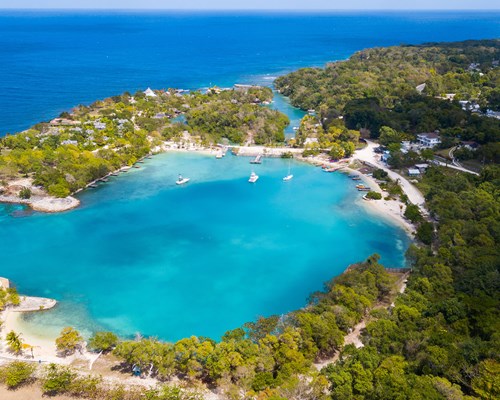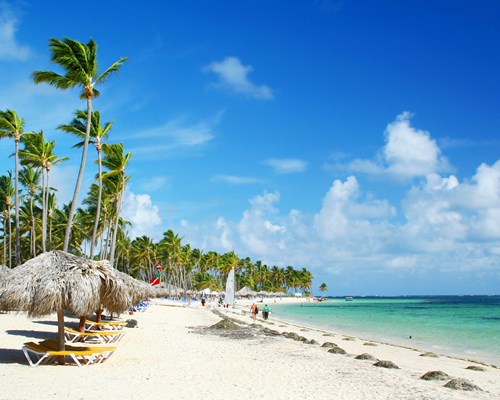With soft white sand beaches, palm trees and glistening waters, holidays to Jamaica make the perfect Caribbean getaway. Basking in the sun all day in Negril or partying the night away in Montego Bay – you'll be alright, right here.
Beaches in Jamaica
Sure, the inland activities here are terrific, but most of us come to Jamaica for the beaches. Lots are privately owned by resorts and clubs, and you’ll also find local favourites hosting evening reggae jams and home to sizzling Jerk shacks. Buzzing beaches are nearby markets and cruise ports, while others are deliciously secluded. From the surfy east end of the island to the bohemian west, the sand comes in shades of gold, white and whiter and the sea is a brilliant blue.

Montego Bay
You’ll find Jamaica’s biggest beach destinations on the north and west coasts of the island. Montego Bay’s the tourist capital with more hotels than anywhere else; popular for having the shortest airport transfers (Sangster International is only 3 miles away) as well as some fabulous golf courses. You’ll find dozens of all-inclusive resorts set along the seafront - many hogging private stretches of the white sands and calm, reef guarded waters that trim this coastline.

Ocho Rios
Almost slap bang in the middle of the north coast is Ocho Rios, home to the island’s busiest cruise port and a close-knit collection of accommodation and attractions. All inclusive resorts and villas line the classically Caribbean beachfront, and there’s everything from the Dunn’s River waterfalls to Dolphin Cove within easy reach to fill your week with.

Orchabessa
To its east is idyllic little Orchabessa, with its beyond-luxurious hotels and villas, while westwards, Runaway Bay and Discovery Bay have their own huddles of places to stay in smaller, quieter settings than Ochi proper.

Negril
Negril is as west as this island gets, and its beaches could only be reached by boat before the road was built in the fifties. There aren’t oodles of activities close by, but with beaches like these, you probably won’t want to budge from the seafront anyway… They’re spectacular, with miles-long stretches of sand, clearer than clear waters, cliffs to ogle at (or jump into the sea from) and sunsets that’ll make your jaw drop. A handful of all-inclusive resorts mix with indie boutique hotels here, facing beaches, built into cliffs and hidden among trees – no lodgings can be taller than the tallest palm, which keeps the place feeling rural.
Jamaica geography
Jamaica history
Wildlife in Jamaica
Activities in Jamaica
Watersports
Diving in Jamaica
PADI diving centres are dotted along the Jamaican coast, offering courses and tours in varying levels of difficulty where you can swim amongst rays, nurse sharks, turtles and all manner of coral and fish. The Montego Bay Marine Park is one of the island’s biggest underwater attractions, spanning 10 square miles and easily reachable from the beaches.
There are oodles of wrecks around the island, from the Texas (a former American naval ship) near the sunken pirate city of Port Royal to the Kathryn mine-sweeper off Ochos Rios and the planes and tugboat around Negril. You’ve also got access to dozens of natural caves, reefs and walls, with famous sites including the Widowmaker’s cave and Rose Hall Reef in Montego Bay.
Snorkellers will find fabulous conditions from Doctor’s Cave Beach in MoBay and Seven Mile Beach in Negril, and some activity companies provide trips to snorkel sites further out. If you want diving and snorkelling to be a major part of your trip in Jamaica, try and visit between June and September as this time of year tends to see the warmest, clearest waters.
Surfing in Jamaica
While most of the beach resorts sit on the north and west coast, you’ll find the best surf breaks to the east in the parishes of Portland, St Thomas and St Andrew. Here, life’s all about riding on brilliant blue waters, then collapsing on the sand and feasting on the goods served in beachside Jerk huts.
Portland’s Boston Bay is one of the best spots, with reef breaks creating good left and right-handers. Makka Beach in Yallahs, Saint Thomas has a point break, for long, consistent left-handers helped by easterly swells – this is where the Makka Pro surfing competition has been taking place for the last decade or so.
One of our favourites is Bull Bay in St Andrew, where the legendary Zoo wave has been a haunt of serious surfers since the seventies. Look up Jamnesia, who provide board hire, lessons and Surfaris here – the Wilmot’s have been surfing Jamaica for nearly as long as there has been surfing in Jamaica: Billy was one of Jamaica’s pioneering riders and his son Icah represents the island in international competitions (and more often than not, brings home the trophy).
Windsurfing & kitesurfing in Jamaica
June, July and August are the best months for windsurfing in Jamaica, and you’ll find some of the best conditions on the Falmouth beaches between Montego Bay and Ocho Rios. You can also usually find equipment in the bigger resort hotels, where guests can enjoy the light winds and clear waters moments from their bedrooms.
Kiteboarding’s becoming a big thing in the Caribbean, and if you have your own equipment you can set off from some cracking launch points on Doctor’s Cave and Cornwall beach in MoBay. Between Montego Bay and Ocho Rios, the beaches of Falmouth are kiting central, home to Kiteboarding Jamaica and Kitesurf Jamaica who both provide lessons and rentals. Catch the right breeze (the range is usually 15 - 25 mph) and you’ll skim over clear-as-can-be waters looking over beautiful sands and greenery.
Sailing in Jamaica
Montego Bay is the sailing hub of the island, the endpoint to the famous Pineapple Cup Race from Miami and home to the Montego Bay Yacht Club. Bareboats and crewed sailboats are available to hire, and there are official ports at Montego Bay, Ocho Rios and Discovery Bay as well as other harbours - a coastwide clearance form lets you sail freely along the coastline.
If you’re looking to learn or practice, a lot of the bigger resort hotels have a fleet of Hobies with instructors to provide the know-how – available to children and adults from beginners to more seasoned sailors. The most popular way to spend some time on the deck is through organised tours, which include sunset cruises and snorkelling trips setting off from the main beaches.
Fishing in Jamaica
The north coast is excellent for sport fishing, largely thanks to the presence of the Cayman trench a mile or so offshore. Charter companies arrange deep drop tours for the likes of snapper and grouper as well as big game trolling for marlin, sailfish and wahoo. Light tackle fishing is also available and there’s a sizeable flat off Montego Bay where you can bonefish for barracuda. The best way is to book a trip with a local fishing company who’ll provide captain, crew and equipment - usually, your catch is cooked on the beach as soon as you land, for a seriously fresh supper.
One of the biggest fishing events of the year is the Montego Bay Yacht Club’s Marlin tournament, where competitors take to “Marlin Alley” off Montego Bay every September. Over in Negril, the locals have been spearfishing for donkey’s years and if you ask around, you can usually find someone willing to show you the ropes. The same goes for tarpon fishing in the South Negril River.
Canoeing & kayaking in Jamaica
River kayaking is popular in the White, Bueno and Nuevo rivers, which flow into the sea on the north coast of the island over rapids, currents and deep natural pools. Near Negril, kayak and canoe safaris take you through the Great Morass passed mangroves and all manner of birds and fish that inhabit the wetlands. If you prefer to paddle on the sea, most of the bigger hotels and beach clubs have a fleet of sit on top kayaks which let you pootle along the coast visiting beaches and islets.
Land activities
Golf in Jamaica
Golfers are best based in Montego Bay or Ocho Rios, where the bulk of the island’s courses trims the coastline – enough to try a different one each day of the week.
In MoBay, the White Witch course on the former Rose Hall plantation often crops up in lists of the best in the Caribbean, with 16 of its 18 holes looking out to the sea. Designed by Robert Trent Jones Sr., the Half Moon is repeatedly crowned Jamaica’s best golf resort in the World Travel Awards and hosts PGA tournaments including the European Senior Tour.
Over in Ochi, the Sandals course is well worth a round or two, with natural fairways up in the hills looking out to the sea and mountains. John Harris is the brains behind the Runaway Golf Club, a championship course that hosts the Jamaica Open and the Ryder Cup. If you’re based in Negril, the Negril Hills is your main club, with 18 holes on sloping greens and natural water hazards.
Cycling & mountain biking in Jamaica
Cycling companies operate in the big resort areas – like Juju in Negril and Blue Mountains Bicycle Tours in Ocho Rios – running tours near and far across the landscape. We love the trails in the Dolphin Head Mountains near Negril, and the Konoko path near Ochos Rios takes you over hills and past waterfalls. There’s also a good route along the Martha Brae River, where you can rest your wheels and try river rafting if you fancy a change of pace. If you want to head further out, there are some brilliant routes in the Blue Mountains where you can ride between villages and coffee plantations.
Walking & hiking in Jamaica
As you’d expect from an island of this size and diversity, there’s oodles to explore on two feet. Serious hikers can scale Jamaica’s highest peak on the Blue Mountain trail, which passes the plantations of the legendary Blue Mountain coffee.
The mountain range is on the eastern end of the island, further out from the main resort areas - Ocho Rios is the nearest with the drive taking 3-4 hours. But if you’re happy to make the journey over, it’s spectacular. One of the best ways to experience it is on an overnight tour, where you stay in a nearby inn then set off in the early hours to reach the peak in time for sunrise. If you’re based in Montego Bay, you can head deep into Cockpit Country for a guided hike along the historic Troy Windsor Trail, or for less intense legwork, walk up to the community of Mount Zion – immortalised in reggae lyrics and offering one of the warmest welcomes we’ve ever received (complete with ice-cold Red Stripe beer). Those in Negril have the paths to the Mayfield Falls within an hour’s drive, as well as the glorious 8-mile beach for one of our favourite beach, walks on earth.




